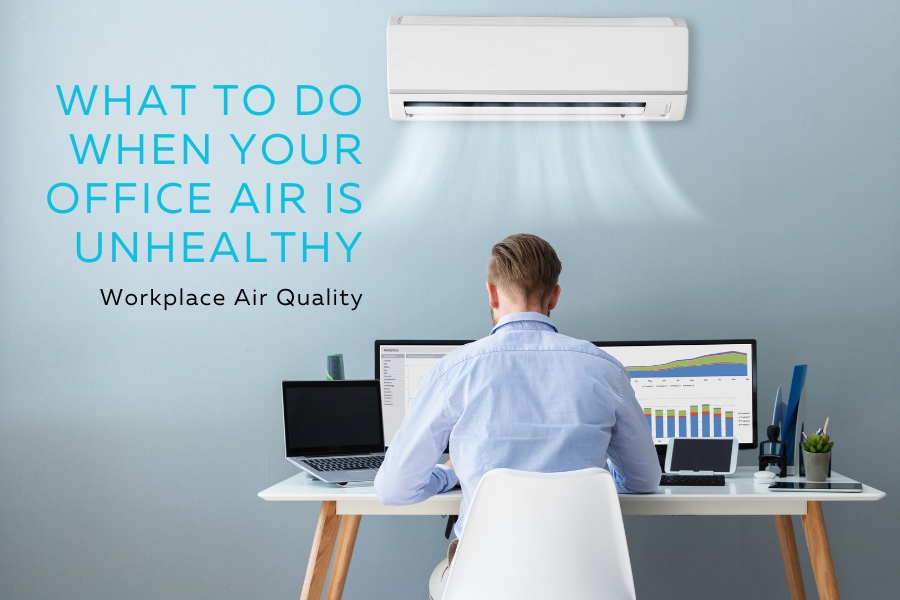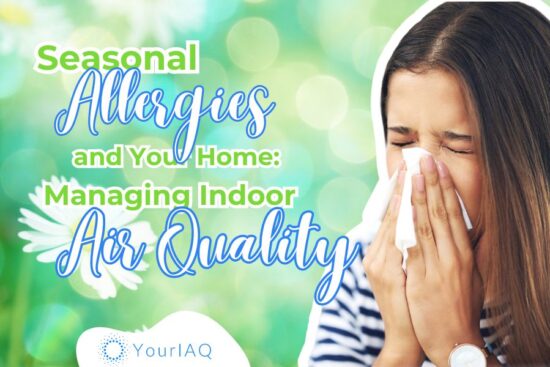
As more employees return to the office post-COVID, making sure working environments are healthy and safe is a renewed priority. A sometimes overlooked aspect of workplace health is air quality. Since employees spend a lot of time at work, exposure to pollutants in the office can impact health and productivity. If you’re concerned that your office air is unhealthy, here are some steps you can take to improve the situation.
Identify Sources of Air Pollution
Poor air quality can be caused by many factors, including inadequate ventilation, subpar cleaning practices, and pollutants such as dust, mold, or volatile organic compounds (VOCs).
Observe the air quality in your workplace. Do you notice any musty smells, dust, or visible signs of mold? Is the air too dry or too humid? Are there any unusual odors or chemical smells? If you notice any of these signs, you should address them promptly.
One of the most effective ways to improve air quality quickly is to increase ventilation. Make sure your workplace has a well-maintained HVAC system that is capable of circulating and filtering the air effectively. Update air filters regularly and invest in a HEPA filter to help reduce the effects of particulate matter.
If you work in a small or poorly ventilated space, consider a portable air purifier to help clean the air. Open windows and doors to improve airflow. Avoid using toxic cleaning chemicals or air fresheners that can release harmful VOCs into the air.
Be Aware of Invisible Organic Threats
Biological pollutants are a common culprit of poor indoor air quality. These include pollen, dust, and mold. Each of them is highly dependent on local climate, temperature, humidity, and who is occupying the indoor space. For example, if you work in a pet-friendly office, pet dander or pollutants tracked indoors by animals are a risk.
One of the most dangerous sources of indoor pollution is mold, which is caused by high humidity or water intrusion. If you suspect mold is present in your workplace, it’s important to address the problem quickly.
Mold can cause a range of health problems, including allergies, asthma, and respiratory issues. It thrives in damp, humid environments, so the best action is to make sure your workplace is dry and well-ventilated. If you notice any signs of mold, such as musty smells or visible patches, notify your employer or building management.
Dust and other particles in the air can also contribute to poor air quality in the workplace. Regular cleaning and dusting can help to reduce the amount of dust and other airborne particles in the air. Ask your employer to clean the space, replace air filters, and maintain HVAC systems per manufacturer’s instructions.
Take Note of Exacerbating Factors
The problem of low indoor air quality is compounded by your own physical condition. Employees with respiratory issues such asthma or allergies can be highly susceptible to illnesses caused by particles in the air.
Additionally, workplace stress and poor mental health are worsened by low quality air. When combined with breathing unhealthy air, stress can result in physical symptoms such as headaches, fatigue, and respiratory problems. Mental health issues such as depression and anxiety can reduce immune system function and make you more susceptible to illness.
Employers should take steps to create a healthy and supportive work environment that prioritizes employee wellbeing and mental health. This is an issue that leads to increased productivity and satisfaction among employees, and thus provides benefits for any business.
Monitor the Air
Most homes and offices today have a smoke detector (or fire alarm system) as well as carbon monoxide detectors to alert building occupants to any imminent dangers. Make sure your office has these devices at a minimum.
However, there are other sensor-based devices that are also worth looking into. For example, prolonged exposure to high levels of Carbon Dioxide can contribute to fatigue and lack of ability to concentrate. Co2 levels increase throughout the day when multiple people are in an enclosed space with limited ventilation. A Co2 monitor is a good investment for any office environment.
Additionally, radon is a natural gas emitted from the earth that can be unsafe. Is your place of work located in an area with high radon emissions? Only a professional inspector or a specialized monitor can tell you for sure, and radon levels fluctuate naturally, so you’ll need ongoing coverage.
A complete indoor air quality monitor like IAQ measures for Co2, radon, and more than 20 potentially harmful indoor contaminants in real time. Consider investing in multiple IAQ monitors or a similar device to get ongoing readings of what is in the air, including alerts when levels of unhealthy air elevate.
Conduct a Professional Assessment
You can greatly improve indoor air quality by taking some of the practical steps mentioned above. However, there are also scenarios in which the solution requires professional intervention. A good first step for air quality concerns is to speak to your employer or building management about conducting an air quality assessment. This can help identify any problems and suggest practical solutions.
For workplaces with employees with specific health concerns, such as asthma or allergies, consider consulting a healthcare professional who can provide advice on how to manage symptoms or improve the ambient environment.
Additionally, the detection of some indoor pollutants may require the help of a licensed professional. Mold and radon, for example, may require specialized equipment beyond basic remediation tactics. When in doubt, it never hurts to consult the experts.
12 Steps for Employers to Create a No-nonsense Clean Air Workplace
If you’re an employer or manager responsible for creating a healthy workplace environment, the following are some concrete steps you can consider to ensure everyone is breathing healthy air while on the clock:
- Regularly clean and maintain ventilation systems, including air filters, to ensure proper functioning and minimize the presence of pollutants.
- Regularly clean and disinfect common spaces. Use natural, non-toxic cleaning agents, such as vinegar and baking soda to avoid introducing harmful chemicals into the air.
- Ensure working spaces have options for natural ventilation whenever possible, including opening windows and doors to allow fresh air circulation.
- Tip: Create designated “clean air zones” within the office where employees can take breaks or engage in activities that promote relaxation and stress reduction.
- Implement a no-smoking policy inside and around the workplace to prevent exposure to secondhand smoke.
- Establish designated areas for printers, copiers, and other equipment that emit volatile organic compounds (VOCs) to contain their impact.
- Tip: Consider policies that limit the use of strong-smelling products, such as perfumes and colognes, to reduce the presence of VOCs in the air.
- Encourage employees (often with monetary incentives) to use eco-friendly transportation options such as carpooling, public transportation, or cycling to reduce vehicle emissions.
- Tip: Organize “car-free days” or “bike-to-work” initiatives to promote sustainable transportation options and reduce nearby vehicle emissions.
- Place indoor plants strategically throughout the office space, as they can help remove airborne pollutants and improve air quality.
- Tip: Consider a green living partition in the office to enhance aesthetics but also help filter the air by absorbing pollutants and releasing oxygen.
- Introduce flexible working hours or remote work options to reduce the number of employees present in the office at any given time, minimizing overall pollutant levels, especially from elevated Co2.
- Tip: Encourage employees to bring in personal desktop plants to add a touch of nature while contributing to reduced Co2 levels.
- Implement proper waste management and recycling practices to prevent the buildup of pollutants from trash that could affect indoor air quality.
- Tip: Implement a green purchasing policy that prioritizes environmentally friendly products and equipment, including those with low emissions and minimal packaging.
- Control moisture levels to prevent mold growth, which can lead to poor air quality. Fix any leaks or water issues promptly.
- Conduct regular air quality assessments and consider investing in air purifiers or other air filtration systems if necessary.
- Invest in air quality monitoring devices to provide ongoing measurement of pollutants in the office air.






